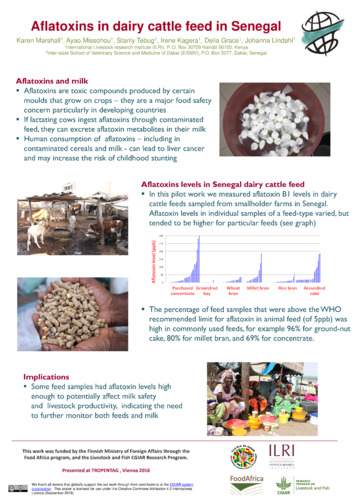Aflatoxins in dairy cattle feed in Senegal
Abstract
Aflatoxins are toxic byproducts from moulds, especially Aspergillus flavus. These moulds grow on crops, and in particular maize and ground nuts are often contaminated. In humans, aflatoxins cause rare, high case fatality outbreaks (acute aflatoxicosis) while long term consumption leads to hepatocellular cancer (globally, around 20,000 deaths annually). Aflatoxins are also associated with childhood stunting, although a causal relation is not yet proven. Humans are exposed through the consumption of contaminated foods, including cereals, legumes and human and animal milk (as aflatoxins are excreted in milk). Similarly in livestock, aflatoxins cause hepatic disease, immunosuppression and reduced productivity. In tropical and sub-tropical developing countries, aflatoxins are common and 4.5 billion people are chronically exposed. In addition to the burden of this exposure, the reduction in livestock productivity impacts food security and trade and hence increases aflatoxins' total burden. Knowledge about aflatoxins in Senegal is scarce, especially in relation to the dairy cattle value chain. In this pilot project we measured aflatoxin B1 levels in dairy cattle feeds. Feed samples were obtained from low-input cattle farms in two regions in Senegal (the Thies and Diourbel regions) in August 2015, with between 16 and 36 samples per feed type. Aflatoxin levels were determined by a commercial competitive ELISA. Feeds with the highest levels of aflatoxin were purchased concentrate (with an average of 50 ppb, and a range of 0 to 305 ppb), ground-nut cake (45ppb, 0 to 187ppb) and millet bran (37ppb, 0 to186 ppb). A number of other feeds tested contained aflatoxins at lower levels, namely cornmeal (18ppb, 0 to 104 ppb), wheat bran (9ppb, 0 to 41 ppb) and rice bran (7ppb, 0 to 58ppb). The percentage of feed samples that were above the World Health Organisation's recommended limit for aflatoxin in animal feed (of 5ppb) was high, for example 96% for ground-nut cake, 80% for millet bran, and 69% for concentrate. Although, the aflatoxin levels reported may not significantly affect herd productivity, their impacts on susceptible livestock and carry-over to animal source food may be problematic. Overall, these results suggest the need for further investigation on aflatoxin in Senegal dairy.

